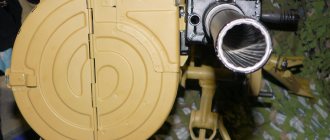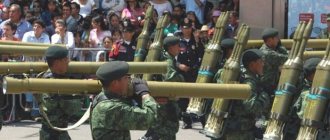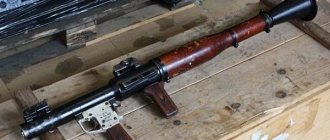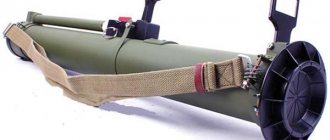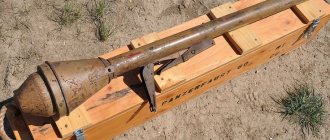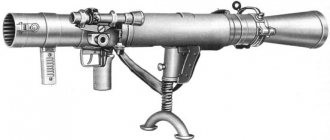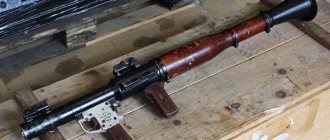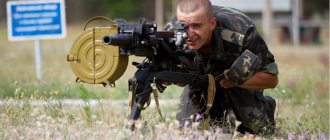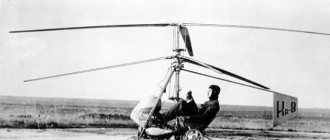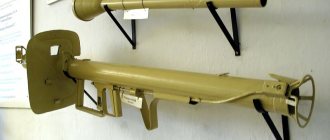RPG-16 "Udar" is a Soviet anti-tank grenade launcher that was developed specifically for the Airborne Forces in the late 60s. It was put into service in 1970. Externally, this weapon strongly resembles another famous Soviet hand grenade launcher, the RPG-7. However, unlike the latter, the RPG-16 could only use one type of ammunition - the PG-16V cumulative caliber grenade.
Design
The RPG-7 is a lightweight dynamo-reactive (no recoil when fired) weapon.
The grenade launcher and shot were based on the reusable recoilless launcher and shot with an over-caliber warhead, which had proven themselves in the RPG-2. The grenade launcher consists of a barrel with optical and mechanical sights, a trigger mechanism with a safety catch, and a firing mechanism.
Grenade launcher barrel
The barrel of a grenade launcher consists of a pipe and a pipe and serves to direct the flight of the grenade and remove powder gases when fired. Unlike the RPG-2, the RPG-7 grenade launcher has an extension of the barrel in its middle part - a charging chamber - to more fully utilize the energy of the propellant charge, and a bell in the breech - to ensure recoillessness of the complex.
Trigger mechanism
Trigger mechanism - used to release the hammer, strike the firing pin and engage the safety.
Sights
PGO-7V1 optical sight reticle - sight scale, 2 - lateral correction scale, 3 - rangefinder scale
Bulgarian soldier with a training (MILES) version of the RPG-7 grenade launcher, equipped with a collimator sight
Mechanical sight
A mechanical sight is used in case of damage (failure) of the optical sight.
Optical sight
The main one for the RPG-7 is the PGO-7 optical sight (or its modifications PGO-7V, PGO-7V-2, PGO-7V-3). The optical sight is designed to monitor the battlefield, determine the distance to the target, introduce corrections for the range and speed of the target, taking into account the ballistics of various ammunition, and point the grenade launcher at the target, taking into account the corrections.
The sight is an optical system of lenses and prisms, enclosed in a sealed metal case filled with dry nitrogen to prevent fogging. The optical sight provides a fixed apparent target magnification of 2.7 times. The sight is equipped with a set of light filters that improve visibility in difficult weather conditions. To prevent unmasking glare from the sun and contamination, the sight is equipped with a rubber cap that fits onto the lens.
The PGO-7V sight reticle has a developed correction scale, as well as a rangefinder scale, which allows you to quickly determine the range to a “tank” type target (2.7 m high). The handwheel provides input of aiming angles in the range of 0-51.2 artillery units, and the aiming mark on the reticle: 0-45.7. In poor lighting conditions, the sight reticle can be illuminated. The backlight lamp uses galvanic batteries A316 or 2РЦ63.
The sight retains its characteristics over a wide temperature range (from −50 to +50 °C), and is also able to withstand high mechanical loads.
Night optical sight
The RPG-7 grenade launcher can be equipped with first-generation night sights (such as the specialized PGN-1 grenade launcher night sight or the NSPUM universal night sight (product 1PN58)) or second-generation NSPU-3 night sights.
For a grenade launcher with a night sight, a light-blocking mechanism is additionally introduced, which prevents the sight from being illuminated by the flame of its own shot.
Universal sighting device
The universal sighting device is a mechanical device weighing 0.55 kg for introducing corrections into the optical sight. It has been used since 2001 in grenade launchers of the RPG-7V2 (RPG-7D3) modifications in conjunction with an optical sight. Allows you to significantly increase the target firing range of thermobaric (TBG-7V) and fragmentation (OG-7V) grenades: up to 550 and 700 meters, respectively.
Other types of sights
Together with the RPG-7, other sighting devices (including homemade ones) are also used: from homemade mechanical sights to replace damaged original ones, to high-tech laser and collimator sights. Most of these devices do not allow corrections for range and target movement, so they are effective only at short ranges.
References
- ^ abcdefghijklmnopqrst 1996 Forecast, page 4. sfn error: no target: CITEREFForecast_1996 (help)
- ^ab 1996 Forecast, page 3. sfn error: no target: CITEREFForecast_1996 (help)
- Forecast 1996, page 1. sfn error: no target: CITEREFForecast_1996 (help)
- "Archival copy". Archived from the original on 2011-08-09. Retrieved 8 August 2011.CS1 maint: archived copy as title (link)
- Isby, David C (1988). Weapons and tactics of the Soviet Army
(Completely revised ed.). United Kingdom: Janes Publishing Company Limited. pp. 199–200. - Anti-tank grenade launcher RPG-16 (USSR / Russia) – Modernfirearms.net
- RPG-16 - Military-Today.com
- RPG-16 – Weaponsystems.net
- Small Arms Review (2012). "Battlefield Research: Illegal Weapons in Afghanistan, Iraq and Somalia" (PDF). Small Arms Review 2012: Moving Targets. Cambridge University Press. p. 324. ISBN 978-0-521-19714-4.
Small arms, ammunition, devices and accessories of the 19th-21st centuries
The site is a private collection of materials on the topic “firearms and ammunition” and is an amateur information and educational weapons portal. All information was obtained from open sources. The administration does not claim authorship of the materials used - all rights belong to their owners. The administration is not responsible for the use of information, facts or opinions posted on the site.
- Account Registration
- Weapon
- home
- Rules
RPG-16 hand-held anti-tank grenade launcher: history of creation, description and characteristics
RPG-16 "Udar" is a Soviet anti-tank grenade launcher that was developed specifically for the Airborne Forces in the late 60s. It was put into service in 1970.
Externally, this weapon strongly resembles another famous Soviet hand grenade launcher, the RPG-7.
However, unlike the latter, the RPG-16 could only use one type of ammunition - the PG-16V cumulative caliber grenade.
History of the creation of the RPG-16
For most of its history, the Soviet Union had the world's largest and most powerful airborne forces.
Paratroopers have always been considered the elite of the armed forces, the best were selected from them, and great attention was paid to equipping airborne units. Special weapons and military equipment were developed for paratroopers, the design of which took into account the specific use of these units
Special weapons and military equipment were developed for paratroopers, the design of which took into account the specific use of these units.
The main purpose of the new weapon was to defeat enemy tanks and other armored vehicles, as well as enemy personnel in shelters or various fortifications.
The grenade launcher was put into service in 1970 and received the designation RPG-16 “Udar”.
Despite the strong external resemblance to the RPG-7, the designs of these two grenade launchers differed significantly. Although, in fact, the RPG-16 was a further development of the RPG-7.
When landing, the grenade launcher jumped with a disassembled RPG-16 and two shots for it, and the second crew number had three additional shots for the weapon.
The PG-16V grenade had a powerful engine, thanks to which a greater firing range of the weapon was achieved than that of the RPG-7, and its accuracy increased.
The RPG-16 was actively used in Afghanistan; Soviet soldiers loved this weapon for its good accuracy and significant grenade range.
Later, the grenade launcher was used in various local wars that arose in the territory of the former Soviet Union.
In general, if we talk about the combat effectiveness of the RPG-16 grenade launcher, we can note the following. At the time of its creation, it was a very effective weapon, compact, accurate, with an excellent firing range.
The distance of an aimed shot at a target with a height of two meters was 520 meters. For the RPG-7, this figure was much more modest - only 330 meters. The main and only target for the grenade launcher was enemy tanks.
The problem was that the protection of tanks was increasing rapidly, and it was no longer possible to increase the power of the RPG-16 caliber grenade. Already in the mid-70s, it did not suit the Soviet military.
To increase the armor penetration of the RPG-7, it was possible to simply increase the size of the over-caliber warhead of the grenade. In 1977, a new PG-7L ammunition (warhead caliber 93 mm) was manufactured for this grenade launcher, which could penetrate 500 mm of tank armor.
The trigger mechanism includes an induction generator, a cocking lever, a pusher, a safety and a trigger.
The RPG-16 is equipped with a PGO-16 optical sight with a magnification factor of 2.7. The iron sight bar has a scale from 200 to 800 meters in increments of 100 meters. At positive temperatures, aiming is carried out at the front sight. If it drops below zero, the front sight folds back and the protrusion on its base serves as a guide.
Characteristics of RPG-16
Below are the main characteristics of the RPG-16:
- weapon weight, kg – 10.3; sighting range, m – 800; direct shot range, m – 520; practical rate of fire, rds/min – 5-6; crew, pers. – 2.
The first Soviet RPG
The active use of powerful anti-tank weapons by opponents and allies of the USSR in 1943 forced Soviet gunsmiths to speed up experimental work on rocket-propelled anti-tank grenade launchers. The first positive results were achieved already at the beginning of 1944 by engineers at a research site near Moscow.
First steps
At the beginning of the war, the Soviet military leadership did not see much promise in light anti-tank grenade launchers. Their niche was firmly occupied by anti-tank rifles PTRD and PTRS. As an option to increase the power of light and maneuverable anti-tank weapons, more powerful anti-tank guns chambered for 14.5 mm and 20 mm cartridges with a high muzzle velocity were considered.
The first technical requirements for the development of a hand-held large-caliber anti-tank rocket launcher in the Main Artillery Directorate (GAU) appeared on December 11, 1942. With the help of such weapons, penetration of 50 mm of armor was calculated at a distance of up to 400 m at an angle of 60 degrees. The weight of the system in combat position should not exceed 12 kg. Shooting was supposed to be done while lying down, kneeling and standing. There is no information about any work on such weapons in 1943, except for the development of a heavier anti-tank rifle designed by Ostrovsky.
Reactive cumulative anti-tank mine "Faust", January 1944, TsAMO RF
The sharp increase in the development of rocket-propelled grenade launchers (RPGs) in the USSR at the beginning of 1944 is due to the fact that in the fall of 1943, German troops began to actively use the disposable “Faustpatron” and the reusable “Ofenror”. Already in January 1944, detailed instructions on the construction of German grenade launchers and their handling began to arrive at the front. Already on January 31, an order was issued by the GAU Art Committee to develop new powerful short-range anti-tank weapons.
Kazanovich group
First of all, American, English and German grenades were tested at the Small and Mortar Weapons Research Site (NIPSMVO), which showed the significant superiority of the latter, penetrating 180-230 mm of armor. Simply copying foreign charges using other materials did not bring a similar result and showed a significant reduction in armor penetration. A group of engineers was formed at NIPSMVO under the leadership of Kazanovich, which also included Gribakin, Boroshnev, Lominsky and Renberg. They started designing the first domestic RPG almost from scratch.
The first stage of work took place at NIPSMVO from February 5 to April 12, 1944. First of all, it was determined that using a machined funnel instead of a welded one gives a greater cumulative effect. The optimal charge was determined to be an alloy of TNT with hexogen TG-50. The charge with a hole in the top of the funnel showed the maximum result. Having compared different forms of charge with a lack of time for further experimentation, the designers recognized the most advantageous form with a cylindrical head and a tail in the form of a truncated cone in a 1:1 ratio. The wall thickness of the steel funnel was taken to be 2 mm, which turned out to be the most favorable based on the results of numerous experiments conducted in 1942-1943 at the Gorokhovets Artillery Scientific Testing Experimental Site (ANIOP). For the design of ammunition, two variants of charges with a diameter of 70 and 90 mm with an estimated armor penetration of 150 and 200 mm, respectively, were chosen.
At the same time, the design of the grenade launcher was also being worked out. One of the options considered was the use of standard weapons of the Red Army by converting PTRDs with worn-out barrels. Another option based on the gas-dynamic principle with no recoil seemed more familiar. As a result of this work, three versions of the grenade launcher appeared - “A”, “B” and “C”.
Firing from a grenade launcher “A”, 1944 TsAMO RF
The “A” grenade launcher was obtained by altering the PTRD with shortening the barrel, moving the bipod and handle, replacing the sighting device and the bipod mount. The grenade stabilizer was a smooth-walled tube with six feathers. Throwing a 70-mm over-caliber grenade was carried out by a charge of P-45 gunpowder placed in a blank cartridge of a 14.5-mm cartridge case, closed with a paper wad.
The “B” grenade launcher was a tube open at both ends with simple sighting devices and a trigger mechanism. For firing, an over-caliber feathered grenade was used, similar to the A-70 system, only with a four-finned ring stabilizer with an additional black powder propellant charge. The “B” grenade launcher differed from the B-70 only in the increased caliber of the weapon and grenade.
Comparative tests of Soviet grenade launchers and grenades with foreign ones showed that “they are not only not inferior to well-known foreign models of similar purposes, but even significantly superior to them in terms of armor penetration, grenade caliber and weapon weight.”
.
Shooting from a grenade launcher “B” while standing from the armpit, 1944 TsAMO RF
Based on the results of more than two months of work and testing, the conclusion of the test site dated April 12, 1944 read:
"1. Developed and tested grenade launchers and grenades are powerful anti-tank infantry weapons designed to combat armored targets with armor up to 200 mm inclusive at a distance of up to 150 m.
2. In comparison with similar weapons of the enemy and allied armies (“Ofenror ”, “ Panzerfaust ”, “ PzB -39” grenade launcher, American 60 mm rocket gun, British anti-tank rifle “PIAT”), the developed designs have significant advantages, as in combat, and in production and economic terms.
3. In order to quickly finalize these objects, it is advisable to produce a serial batch of grenade launchers and grenades for extensive field and military tests.
4. It is advisable to create an 80 mm grenade designed on the basis of the most effective 70 mm grenade with appropriate preservation of all its optimal parameters and, according to the developed drawings, produce a pilot batch of 250-300 pieces. for comparative field tests of 80 mm and 90 mm grenades.”
Light infantry grenade launcher
In April 1944, a set of drawings of 40 albums on 660 sheets was prepared for all variants of grenade launchers for the production of serial batches and wider field and military tests. According to the new documentation, grenade launcher “A” was named PTG-44 with an AKG-70 grenade, grenade launcher “B” became LPG-70 with an RKG-70 grenade, and grenade launcher “B” was called TPG-90 with an RKG-90 grenade.
From June to August, at Plant No. 143 of the People's Commissariat of Ammunition (NKB), the grenades were modified and an experimental batch was produced - in field tests it showed reliable penetration of 150 mm armor at a distance of 100 m. At the same time, in military tests of the PTG-44 at the "Vystrel" courses the commission “did not recommend the grenade launcher as presented for use in the Red Army due to the large and sharp recoil when firing and the short range”
.
Only the modified LPG-70 made it to extensive field and military testing in 1945. This happened after the surrender of Germany. Resolution GOKO-8668ss dated May 19, 1945 ordered plant No. 2 of the People's Commissariat of Armaments to produce 500 grenade launchers, and plant No. 846 NKB - 11,000 grenades. Tests took place at NIPSMVO from August 29 to September 11, 1945 under the leadership of senior technician-lieutenant Lominsky.
Firing from an LPG-44 grenade launcher while standing from the shoulder, 1945, TsAMO RF
15 grenade launchers manufactured by Plant No. 2, as well as 970 grenades manufactured by Plant No. 846 and equipment from Plant No. 11 were subjected to field testing. The LPG-44 light infantry grenade launcher was not much different from its predecessor, retaining almost the same characteristics. The main modifications were made to the GK-70 grenade, which had problems with the operation of the fuse. The bottom inertial fuse was a modified fuse of the VKG-40 grenade (GSKB-30 design).
Firing from the LPG-44 was carried out from standing positions from the shoulder and from the armpit, from the knee from the shoulder and from the armpit, as well as lying down. To fire a shot, you must first insert the fuse into a special socket in the bottom of the grenade, and then place the stabilizer tube on the muzzle of the grenade launcher, aligning the barrel cutout and the grenade protrusion. After this, by pulling the tail of the trigger back, the fighter cocks the firing mechanism, and the grenade launcher is ready to fire. In practice, such manipulations showed a combat rate of fire from 9 to 12 rounds per minute.
The armor penetration of the GK-70 was determined both by the stationary detonation of grenades on 150-mm plates of homogeneous armor, and by firing at them and the German Tiger tank. Stationary explosions of serial grenades showed worse results in comparison with experienced ones equipped with NIPSVMO. Shooting at slabs at distances of 25, 50 and 75 m showed stable results and provided 100% through holes. When grenades hit the tank's frontal armor, in all cases, through holes were obtained, and individual hits led to the ignition of oil in the crankcase, destruction of the gun's lifting mechanism and jamming of the turret. At the same time, the not entirely satisfactory quality of grenade equipment from Plant No. 11 and unstable armor penetration were noted.
The shooting also revealed contamination of the trigger mechanism with powder gases after 15-30 shots, which led to misfires and jamming of the trigger. In total, out of 750 shots, 691 grenades worked normally. In addition to fuse failures when hitting armor and ricochets, “dead” failures were observed, expressed in a deep or, conversely, high landing of the primer in the grenade body, making their practical use impossible. The resulting 7.9% of failures, although significant, were in most cases eliminated on the spot.
Firing from an LPG-44 grenade launcher while sitting from an armpit, 1945 TsAMO RF
In the conclusion of the test site it was stated that the LPG-44 light anti-tank grenade launcher and the GK-70 cumulative grenades for it “passed the test site tests and the system as a whole can be recognized as a completely reliable and effective means of combating armored targets at short ranges, not inferior in its combat and service characteristics of known foreign models of similar purpose"
. To finalize the system, it was necessary to eliminate the shortcomings and comments indicated in the final report of NIPSMVO.
And yet the first!
The grenade launcher, modified in 1946 by the designers of the Design Bureau (PKB) of Plant No. 2 in Kovrov, differed in appearance only in the wooden barrel linings to protect the shooter from heating the barrel during intense shooting. In 1947, a draft brief manual for the grenade launcher was published, and in 1948, the Art Committee of the GAU approved the drawings of the RPG-1 grenade launcher and the PG-70 grenade for it, assigning them the indices 56-G-661 and 57-GK-661, respectively.
RPG-1 grenade launcher, 1946 Encyclopedia of Kovrov weapons, 1918-1966
The further fate of the RPG-1, which became the first in the future family of Soviet rocket-propelled anti-tank grenade launchers, is not entirely clear.
There is no information about the official adoption or mass production of the RPG-1. By that time, a similar development, GSKB-30, turned out to be more promising. Already in 1949, the RPG-2 grenade launcher and the PG-2 grenade were adopted by the Soviet army, and mass serial production of this model began at the Kovrov plant No. 575 in the 50s. Characteristics of the first Soviet grenade launchers
| Name | AKG-70 | LPG-70 | TPG-90 | LPG-44 | RPG-2 |
| Grenade launcher caliber, mm | 26 | 30 | 45 | 30 | 40 |
| Length, mm | 1250 | 1000 | 1200 | 1000 | 950 |
| Weight, kg | 13,5 | 2,0 | 3,5 | 2,0 | 2,75 |
| Grenade caliber, mm | 70 | 70 | 90 | 70 | 80 |
| Grenade weight, kg | 1,4 | 1,45 | 2,3 | 1,6 | 1,62 |
| Mass of propellant charge, g | 9 | 70 | 110 | 70 | 220 |
| Initial speed, m/s | 58,2 | 43,8 | 35,5 | 40 | 84 |
| Sighting range, m | 150 | 100 | 75 | 75 | 150 |
| Armor penetration, mm | 170 | 170 | 200 | 150 | 200 |
Sources and literature:
- TsAMO RF, fund 3399, inventory 1;
- TsAMO RF, fund 81, inventory 12040;
- RGASPI, fund 644, inventory 2.
- Hand-held anti-tank grenade launcher (RPG-1) and grenade (PG-70). Quick guide. Voenizdat, M. - 1949
- RPG-2 hand-held anti-tank grenade launcher and PG-2 anti-tank grenade. Service manual. Voenizdat, M. - 1954
Ammunition for RPG-7
Shot device for RPG-7
Despite the variety of existing shots for the RPG-7, they all have a similar structure and differ only in the type and structure of the warhead.
The shot is divided into three parts: the head part, which ensures direct destruction of the target, the jet engine, which ensures the acceleration of the grenade along the flight path, and the powder charge, which ensures that the grenade is ejected from the grenade launcher tube.
Diagram of the structure of a PG-7V shot for the RPG-7 grenade launcher
| I - Head part, 1 - head part of the fuse, 2 - conductive cone, 3 - fairing, 4 - cumulative funnel, 5 - body, 6 - bursting charge, 7 - conductor, 8 - bottom part of the fuse, | II - jet engine, 9 - nozzle block, 10 - nozzle, 11 - jet engine body, 12 - jet engine powder charge, 13 - rocket engine bottom, 14 - igniter capsule, | III - powder charge, 15 - feather stabilizer, 16 - paper sleeve, 17 - powder charge, 18 - impeller, 19 - tracer, 20 - foam wad. |
Nomenclature of grenades for RPG-7
The grenade launcher itself has changed little, but grenades of various types have been developed for it: cumulative anti-tank, including tandem, high-explosive anti-personnel, thermobaric (volumetric detonating), incendiary, as well as training and other types of grenades.
| Year | Shot index / GRAU index) | Image | Warhead type | Shot weight, kg | Head caliber, mm | Armor penetration, mm | Initial speed of the grenade, m/s | Sighting range, m |
| PG-7V/7P1 | cumulative | 2,2 | 85 | 260 | 120 | 500 | ||
| PG-7VM/7P6 | cumulative | 2 | 70 | 300 | 120 | 500 | ||
| PG-7VS / 7P13 | cumulative | 2 | 72 | 400 | 120 | 500 | ||
| PG-7VL "Luch" / 7P16 | cumulative | 2,6 | 93 | 500 | 120 | 300 | ||
| PG-7VR “Resume” / 7P28 | tandem cumulative | 4,5 | 64 / 105 | DZ + 650 | 100 | 200 | ||
| TBG-7V "Tanin" / 7P33 | thermobaric | 4,5 | 105 | n/radius of destruction of manpower: 10 m | 100 | 200 | ||
| OG-7V "Oskolok" / 7P50 | fragmentation | 2 | 40 | n/a Explosive mass 0.4 kg, 1000 fragments. The affected area is 150 m². | 120 | 700 |
Anti-tank hand grenade launcher or rocket-propelled anti-tank grenade?
To avoid misunderstandings, hand-held anti-tank grenade launchers will be designated in the text as “ RPGs”, and rocket-propelled anti-tank grenades (light disposable grenade launchers) – as “RPGs*”.
Grenade launchers and grenades
In the weapons system of the armies of the world, RPGs and RPGs* (grenades) occupy far from the last place. For example, in the ground forces of the armed forces of most states, departments (sections) are armed with at least one RPG with a crew of two people.
The USSR, and then Russia, always paid attention to the development and introduction of anti-tank weapons into the troops. Over the past 70 years, domestic industry has created many excellent examples of grenade launchers and rocket-propelled anti-tank grenades, different in principle and purpose.
Here is a classification of some of them:
RPG-2 : caliber - 40 mm, grenade caliber - 80 mm, grenade weight - 1.8 kg, explosive charge weight - 0.4 kg, sighting range - 100 m, armor penetration - 200 mm, complex weight - 2.9 kg (adopted into service in 1972);
RPG-7 (TKB-02) : caliber - 40 mm, grenade caliber - 85.93 or 105 mm, sighting range - 500 m, weight - 6.72 kg, length - 970 mm, RPG-7D - 640 mm disassembled form, shots: PG-7V, PG-7VM, PG-7VL, PG-7VR, TBG-7V (adopted into service in 1963)
RPG-16 (TKB-076) : barrel caliber - 58.3 mm, sighting range - 520 m, longest range - 800 m, length - 1105 mm, weight - 10.4 kg (adopted for service in 1971)
RPG-29 “Vampire” : caliber – 105 mm, weight – 8.3 kg, length – 1780 mm, sighting range – 700 m (adopted for service in 1989), warhead (CU) similar to the PG-7R warhead;
RPG*-18 “Fly” (TKB-076) : caliber – 64 mm, length – 690 mm, weight – 1.3 kg, sighting range – up to 200 m, armor penetration – 200 mm (adopted for service in 1972) ;
RPG*-22 “Netto” (TKB-0125) : caliber – 72.5 mm, length – 765 mm, weight – 3.5 kg, sighting range – 50–250 m, armor penetration – 300 mm, warhead similar to the PG- warhead 9 (adopted into service in 1980).
RPG*-26 "Aglen" : caliber - 72.5 mm, weight - 2.7 kg, sighting range - 200 m, warhead similar to the PG-9 warhead (+ the presence of a second piezoelectric generator in the PIM - guarantee of operation on protective nets and tree branches ), (adopted into service in 1985).
RPG*-27 “Tavolga” : caliber – 105 mm, weight – 7.5 kg, sighting range – 200 m, armor penetration – up to 800 mm, warhead similar to the PG-7R warhead (adopted for service in 1989).
In addition to the classic hand-held RPGs and RPGs*, the following are in service in units of many law enforcement agencies: SPG-9, RPO "Lynx", RPO-A "Shmel", AGS-17 "Flame", GP-25 "Koster" and GP-30 " Shoes."
For the GP-25 (GP-30), VOG-25 (VOG-25P) shots, index 7P17, were created. Shot weight 0.255 kg, explosive - 0.048 kg.
Important little things
Firing RPGs and RPGs* is not as easy as it seems at first glance. The shooter must take into account many factors: range to the target, air temperature, wind speed and direction, speed and direction of target movement, and much more. It should be remembered that jet (dynamo-jet) weapons are characterized by dangerous zones - due to the powder gases ejected back at high speed and temperature. Also, the shooter is subject to strict requirements for correctly determining the minimum permissible volumes of the premises from which the shot is fired. When firing an RPG-7 from a room the size of a small kitchen (7-9 sq. m and a volume of 17-23 cubic meters), the shooter risks being burned by powder gases reflected from the rear wall, shell-shocked (can damage the fire) and even thrown out of the window! Masking a position for a rocket (dynamo-reactive) weapon is of primary importance, especially when there are opportunities for maneuver and change of position. All available means should be used here: from watering the soil with water to lining the area swept by powder gases with tarpaulin and other available materials. Shrubs disperse powder gases very well. Taking into account the significant masses of RPGs and RPGs*, the most effective fire will be in prone and kneeling positions. For RPGs, the presence of a bipod and an optical sight undoubtedly has a positive effect on the accuracy and accuracy of fire.
Grenade launchers against infantry
The nature of the fighting in Afghanistan, Yugoslavia, Karabakh, and Chechnya changed the narrow armor-piercing specialization of grenade launchers. What comes first is the need to destroy enemy personnel and their fortifications with RPGs and RPGs*, and not small armored targets. But high-explosive fragmentation (HE) ammunition is better suited for destroying manpower. Unfortunately, until 2000 - for half a century of the existence of RPGs and a quarter of a century of RPGs * - we never had a serial high-explosive fragmentation warhead. True, even then the authoritative reference book “Jane's Infantry Weapons” indicated the existence of the Russian OG-7 round for the RPG-7, although no one saw it “live” in the army.
In reality, at that time there were Chinese and Arab caliber and over-caliber fragmentation rounds for the RPG-7. And many foreign models, for example the 84-mm “Carl Gustaf” M2-550, have smoke and illumination rounds in addition to cumulative and fragmentation ammunition. The fact that HE warheads are urgently needed is confirmed by the practice of many combat operations. From my own experience I was able to verify the low effectiveness of cumulative warheads when used by the enemy against our personnel. High armor penetration (usually 3-5 calibers) and weak high-explosive fragmentation action led to the fact that when a cumulative PG-7V exploded 4-5 meters from personnel dressed in winter uniforms, then, in addition to light concussions and a couple of holes in jackets and RD-54, there were no other consequences. What if a fragmentation grenade exploded?..
Need a high-explosive fragmentation shot
In order not to be unfounded, let's try to solve a tactical problem.
The figure shows a typical scene of a battle in the city: on the second floor of the building is the position of an enemy sniper or machine gunner. Range – 200 meters. It is clear that the enemy will move from room to room so as not to be hit. The first floor has already been captured by our assault group.
Question: how and with what to quickly destroy the enemy?
The choice is not very large: RPG-7, RPG*-22 (26, 27), RPO-A, GP-25, AGS-17 (30). Having carefully studied the dispersion table and the figure itself, it is easy to conclude that the most effective and accurate will be the use of RPG-7 and AGS-17. It is believed that the VOG-25 is 1.4 times more powerful than the 30-mm OFZ projectile for the 2A42 gun (BMP-2). In practice, this is not entirely true due to the extremely low mass of VOG-25 fragments, comparable to tin. The VOG-30 shot, created by the Pribor State Research and Production Enterprise, is good, having a 1.6 times larger affected area and a five times better utilization rate of the body material compared to the VOG-17.
The use of RPG*-22 (26) will be ineffective and dangerous for friendly troops due to the large dispersion and the possibility of making a mistake in determining the range and sending a grenade to the first floor to your own. And also because the first shot from an RPG*-22 (26) rarely hits anyone. RPO-A or RPG*-27 will destroy half the house. In addition, a feature of thermobaric ammunition is that the detonation wave “flows” into the lower floors, which can defeat friendly fighters. Equally important is the high probability of the highly sensitive piezoelectric fuse of the RPG, RPG* being triggered on the branches of a tree (although the cap does not need to be removed) and a change in the flight trajectory due to the feathers touching the stabilizer of the branches. Yes, and “driving” such expensive ammunition into each window will be expensive for the budget of any army, and when fighting militants, a lot of money will also be spent on restoring what was destroyed (comparative characteristics of the most powerful ammunition are shown in the table).
Answer: RPGs* have insufficient accuracy and excessive power to solve problems during anti-terrorist operations. By the way, the high cost of training personnel to fire RPGs* and frequent mistakes are also due to the lack of fire control systems and other simulators. The weight of the RPGs or RPGs* themselves, their rate of fire, and the wearable ammunition do not allow full use of the weapon’s capabilities in a short-lived street battle. The simplest, most reliable and cheapest way to destroy this enemy would be to use the AGS-17 (30). But, unfortunately, the AGS is not a hand weapon, and not every department has one. And preparing and putting together a crew to instantly deploy a weapon takes a lot of time.
Where are you, RPG-16?
When conducting combat in mountainous and wooded areas, the picture is somewhat different. The SPG-9, and most importantly the shots for it, although tempting (there is a fragmentation grenade), is difficult and long to carry into the mountains, which does not contribute to the mobility of anti-terrorist units. The remaining long-range weapons are the RPG-29 “Vampire”, RPG-7, RPO-A and AGS-17. Moreover, the RPG-7 has insufficient range for the mountains. For RPO-A, a pack of two shots weighs 21 kg, which is equal in weight to 60(!) VOG-17 shots. The RPG-29 "Vampire" requires a crew of two well-trained fighters and several ammunition carriers. And the price of a grenade launcher and each shot will make any taxpayer groan. In this regard, I remember that there was once an RPG-16 “Udar”. And, perhaps, the RPG-16 was removed from production and armament early. Yes, today it is rather weak for combating armored targets, but for firing a fragmentation grenade at “infantry” targets, especially at long ranges, it would be just right. The grenade launcher was distinguished by exceptionally high accuracy of hits, an excellent “wind-resistant” grenade, it was very simple, reliable and quickly disassembled into two parts for carrying.
The gangs realized the effectiveness of HE ammunition faster than the leadership of the Ministry of Defense and the Ministry of Internal Affairs and began to “reinvent the wheel.” The use of pipes from the UB-32 to launch NURS, and homemade single-shot grenade launchers for the VOG-17, and an increase in the explosive load in RPG-7 grenades and much more are used. Some CIS republics even used all kinds of ersatz to increase firepower.
Drawing the line
From all of the above, the following conclusions can be drawn:
1. The troops urgently need the creation of a hand-held multi-shot grenade launcher for the VOG-17M (30) shot with an increased barrel length for greater trajectory flatness and accuracy. The efficiency, power and reliability of the VOG-17 (30) shot for solving most typical fire tasks during anti-terrorist operations quite sufficient. And if the squad, in addition to the GP-25 (30), had a pair of hand-held multi-charge grenade launchers, then many tactical problems could be solved. Yes, and hitting the enemy with fire from long ranges is beneficial for us, since we will expose fewer people to enemy fire. Moreover, there are already real samples for VOG-17M, for example, TKB-0249 “Crossbow” by V.N. Telesha. As a last resort, you can borrow from the Navy (with appropriate modifications to the ammunition) the following anti-sabotage weapon: the DP-64 Nepryadva double-barreled grenade launcher (caliber - 45 mm, weight - 10 kg, range - up to 400 m, adopted for service in 1990. );
2. TsKIB SOO-KBP, the lead developer of the RPG and RPG*, and their chief designer V.A. Chulitsky, in collaboration with relevant organizations, would like to create high-explosive fragmentation analogues of existing warheads. And ideally, it is necessary to create fragmentation-shrapnel warheads with a given fragmentation of the hull. To comply with the requirements of the Hague conferences that adopted the relevant conventions, ammunition can also be called combined: incendiary-cumulative and cumulative-high-explosive, and even “fragmentation agitation.” The troops should receive both cumulative and fragmentation ammunition, in my opinion, in a ratio of 1:2.
3. Since the tasks of destroying armored vehicles have not been completely removed from grenade launchers during anti-terrorist operations, but rather, they have been transformed into the tasks of stopping breaking through cargo transport, I want to offer unit commanders something new in the training methodology. To increase psychological stability and develop confidence among personnel in their weapons, instilling the skills of firing at high-speed maneuvering targets, use in training grenade launchers to fire an inert (!) grenade at a moving tank (naturally, from a combat training group sent for overhaul). At the same time, you can attach a couple of waist targets to the tower. Let the snipers try to shoot the “crew” in motion. Similar experiments were actually carried out and showed their amazing effectiveness.
Shot characteristics
| Characteristics | RPO-A (Bumblebee) | RPG-22 (26) | PG-7VM (VL) | TBG-7V "Tannin" | RPG-27 (RPG-29) |
| Caliber | 93 | 72,5 | 70/40 (92/40) | -/40 | 65×105/40 (PG-7VR) |
| D. max, m | 600-1000 | 250 | 500 (300) | 800 | 200 (700) |
| D. effective (straight shot) m. | 350 | 160 (170) | 300 (150) | ~150 | 150 (450) |
| Scattering m. at 200 m. | BB 0.50 Wb 0.35 | BB 0.66 Wb 0.66 | BB 0.2 Wb 0.3 | Vv 0.8 Wb 0.8 | – |
| Weight of RPG* (shot) kg | 11 | 3,5 (2,7) | 2,0 (2,4) | – | 7,5 (6,2) |
| Mass of explosives (mixture) kg. Warhead type | 2.1. Volumetric detonating | cumulative | cumulative | 1.8. Volumetric detonating | tandem cumulative |
| Equivalent to a landmine. | ~122 mm OF | ~85 mm OF | ~85 mm OF | ~100 mm OF | ~100 mm OF |
From the editors of "Courage". The need to equip combat units with grenade launchers with high-explosive fragmentation grenades is long overdue. Therefore, after 2000, rocket-propelled assault grenades - RShG, as well as high-explosive fragmentation rounds for existing reusable grenade launchers, were adopted into service by Russian law enforcement agencies and the army.
See also: NEW ANTI-TANK WEAPONS WITH NEW CAPABILITIES , Rocket-propelled grenades with multi-factor damage , 40-mm revolving grenade launchers
Join our group “Courage 2004”
Share on social networks:
Operators
Countries that use RPG-7
|
|
|
|
|
The RPG-7 is also used by illegal armed groups and organized crime in almost all countries of the world.
Users
- Afghanistan [1]
- Armenia [1]
- Azerbaijan [1]
- Belarus [1]
- Bulgaria (not confirmed) [1]
- Estonia (not confirmed) [1]
- Georgia [1]
- Iran (unconfirmed) [1]
- Iraq: Iraqi insurgents [9]
- Kazakhstan [1]
- Kyrgyzstan [1]
- Latvia (not confirmed) [1]
- Lithuania (not confirmed) [1]
- Moldova [1]
- Romania (not confirmed) [1]
- Soviet Union
- Syria (unconfirmed) [1]
- Tajikistan [1]
- Turkmenistan [1]
- Ukraine [1]
- Uzbekistan [1]
History of the creation of the RPG-16
For most of its history, the Soviet Union had the world's largest and most powerful airborne forces.
Paratroopers have always been considered the elite of the armed forces, the best were selected from them, and great attention was paid to equipping airborne units. Special weapons and military equipment were developed for paratroopers, the design of which took into account the specific use of these units
At the end of the 60s, the development of a new anti-tank grenade launcher began specifically for the USSR Airborne Forces; it was carried out by a team of designers under the leadership of I.E. Rogozin. The main purpose of the new weapon was to defeat enemy tanks and other armored vehicles, as well as enemy personnel in shelters or various fortifications. The grenade launcher was put into service in 1970 and received the designation RPG-16 “Udar”.
Despite the strong external resemblance to the RPG-7, the designs of these two grenade launchers differed significantly. Although, in fact, the RPG-16 was a further development of the RPG-7.
The grenade launcher was initially developed taking into account the specifics of the use of airborne troops. It had a collapsible barrel of a larger caliber than the RPG-7 and a caliber rather than an over-caliber grenade. In the traveling position, the weapon was disassembled into two parts and carried in one pack. When landing, the grenade launcher jumped with a disassembled RPG-16 and two shots for it, and the second crew number had three additional shots for the weapon. The PG-16V grenade had a powerful engine, thanks to which a greater firing range of the weapon was achieved than that of the RPG-7, and its accuracy increased.
The RPG-16 was actively used in Afghanistan; Soviet soldiers loved this weapon for its good accuracy and significant grenade range. Although, it must be admitted that the RPG-16 was not used for its intended purpose: the Mujahideen did not have armored vehicles, so the grenade launcher was used to suppress enemy firing points. In Afghanistan, the RPG-16 was used not only by paratroopers, but also by special forces units. Later, the grenade launcher was used in various local wars that arose in the territory of the former Soviet Union.
In general, if we talk about the combat effectiveness of the RPG-16 grenade launcher, we can note the following. At the time of its creation, it was a very effective weapon, compact, accurate, with an excellent firing range. The distance of an aimed shot at a target with a height of two meters was 520 meters. For the RPG-7, this figure was much more modest - only 330 meters. The main and only target for the grenade launcher was enemy tanks. At first, the RPG-16 was not inferior in armor penetration to the RPG-7 grenade launcher (for both types of weapons it was 300 mm), but at the same time it was significantly superior to it in terms of firing range and accuracy. The problem was that the protection of tanks was increasing rapidly, and it was no longer possible to increase the power of the RPG-16 caliber grenade. Already in the mid-70s, it did not suit the Soviet military.
To increase the armor penetration of the RPG-7, it was possible to simply increase the size of the over-caliber warhead of the grenade. In 1977, a new PG-7L ammunition (warhead caliber 93 mm) was manufactured for this grenade launcher, which could penetrate 500 mm of tank armor.
The trigger mechanism includes an induction generator, a cocking lever, a pusher, a safety and a trigger.
The PG-16 rocket-propelled cumulative grenade has a piezoelectric fuse and a starting powder motor. In its design, the PG-16 is similar to the PG-7 grenade; it has a jet engine with one nozzle and six folding stabilizer feathers, as well as two tracers.
The RPG-16 is equipped with a PGO-16 optical sight with a magnification factor of 2.7. The iron sight bar has a scale from 200 to 800 meters in increments of 100 meters. At positive temperatures, aiming is carried out at the front sight. If it drops below zero, the front sight folds back and the protrusion on its base serves as a guide.
RPG-16In addition to the RPG-7D, the Airborne Forces were supplied with the reusable RPG-16 (“Udar”) with a caliber grenade and a longer sighting range. Although externally similar, the design of the RPG-16 is significantly different from the RPG-7.
The grenade launcher consists of a barrel, a locking-contact mechanism, a trigger mechanism, mechanical and optical sights. The detachable barrel consists of a pipe and a chamber with a pipe. The barrel and chamber in the stowed position are carried by a single pack, in the combat position they are connected with a cracker joint, fixed with a movable contact sleeve, gas breakthrough at the junction is prevented by a seal. The front sight and sight are attached to the top of the tube on special bases, to the left there is a bar for installing the optical sight bracket, from below behind the eye and protrusion is the trigger mechanism, and there is also a block with contacts. The chamber is equipped with linings, a tube with a wire, and a housing for the locking-contact mechanism. A folding bipod is attached to the front of the barrel.
Diagram of the design of the RPG-16 hand-held anti-tank grenade launcher: 1 - axes. 2 - front sight casing, 3 - front sight with base, 4 - pipe, 5 - chamber, 6 - lining, 7 - clamp, 8 - locking contact mechanism housing, 9 - striker, 10 ~ striker spring. 11 - switch. 12 - spring. 13 — latch, 14 — rear swivel, 15 — pipe. 16 — tube, 17 — contact, 18 — contact sleeve, 19 — bracket. 20 — casing, 21 — trigger mechanism housing, 22 — generator. 23 - trigger, 24 - safety, 25 - lever, 26 - pusher. 27 - check
The trigger mechanism includes a pulse induction generator, a pusher, a cocking lever, a safety lever, and a trigger. In the “PR” position, the safety locks the trigger.
The PG-16V round consists of a PG-16 anti-tank rocket propelled cumulative grenade with a VP-16 head-bottom piezoelectric fuse and a PG-16P starting powder motor. The head part of the PG-16 is similar in design and principles of operation to the PG-7, the powder jet engine has one nozzle and eight tangential holes, there is a stabilizer with six folding feathers and two tracers. The starting engine contains a charge of nitroglycerin powder in a burning canister, and an ignition device with electric igniters and a charge of black powder. Before loading the grenade, the starting charge is connected to the grenade engine with a stopper, after which the safety cap is removed from the fuse head.
Holding the grenade in the barrel and transmitting the impulse from the generator to the electric igniter of the starting powder charge is provided by a locking-contact mechanism. The grenade launcher, pulling down the cocking lever, cocks the pusher, which, after being released from combat cocking, pushes the generator armature back, which creates an electrical impulse sufficient to trigger the electric igniters. The pulse is transmitted to a terminal block, one wire of which is connected to ground (pipe), and the other
through the contact sleeve and the striker of the locking-contact mechanism, it transmits the impulse to the contact bar and electric igniters. This single-wire circuit protects against an arbitrary shot if the grenade launcher is incorrectly assembled. When an impulse arrives at the electric fuses, a charge of black powder ignites, and from it the entire starting charge ignites. Powder gases push the grenade out of the barrel, ignite its tracers, passing through tangential holes, give it rotation, and the primer is punctured in the pyro-retardant of the grenade engine. After the grenade leaves the barrel, the feathers of its stabilizer open, then the jet engine turns on, and the fuse is cocked at a distance of 3-20 m from the muzzle. The rotation of the grenade promotes the deployment of the stabilizer and compensates for deviations in the engine thrust vector in flight. The distance from the breech end of the barrel to the wall of a trench or structure when fired is at least 2 m.
PG-16V round: 1 — fuse head, 2 — safety cap, 3, 20, 60 — gaskets, 4, /5› 39 — bushings, 5 — fairing, 6 — cone, 7 — wrapper, 8 — clamping ring, 9, 34. 40 - rings, 10 - funnel, 11 - conductor, 12 - explosive, 13 - body, 14 - screen, 16 - gasket, 17 - insulator, 18 - thrust bushing, 19 - bottom of the fuse, 21 - thrust ring, 22 — transition bottom, 23 — pyromotar, 24 — compensator, 25 — sustaining powder charge, 26, 32 — nylon thread, 27 — chamber, 28 — diaphragm, 29 — nozzle, 30 — washer, 31 — tracer, 33 — feather, 3b - plug, 37 - axis, 38 - pin, 41 - stopper, 42 - spring, 43 - outer tube, 44 - washer, 45 - ring, 46, 57 - wads, 47 - nozzle, 48 - electric igniter, 49 ~ pipe, 50 - gunpowder, 5! - cap, 52 - inner tube, 53 - canvas, 54 - gunpowder, 55 - NBL gunpowder, 56 - cotton fabric, 58 - cork, 59 - bottom, 61, 65 - wheels, 62 - tire, 63 - body, 64, 67 - contact, 66 - safety ring, 68 - plug, 69 - wire, 70 - rivet, and - tangential hole.
The PGO-16 optical sight of a prismatic type with a magnification factor of 2.7x and a field of view of 13° is structurally similar to the PGO-7, but has a different sighting reticle. The scale division of the sight is 100 m, the numbers 3,5,7 correspond to ranges of 300,500 and 700 m. The lateral correction scale division is 0-05 (5 thousandths). The rangefinder scale is designed for a target height of 2.7 m. The mechanical sight bar is notched from 200 to 800 m through 100 (numbers from 2 to 8). When the air temperature is above zero, aiming is done at the front sight; when the air temperature is below zero, the front sight is folded back and the protrusion of its base is used.
The grenade launcher with ammunition is dropped on the paratroopers themselves in canvas bags and covers. For educational and practical purposes, grenades are used in inert ammunition, painted black to distinguish them from the protective color of combat ones.
By now, the RG1G-16 is outdated and suitable only for combating light armored vehicles or field fortifications.
Characteristic
RPG-16 with PG-16V shot: Grenade launcher caliber - 58.3 mm Grenade caliber (largest diameter) - 58.3 mm Grenade launcher length - 1104 mm in firing position, 645 mm in landing position
Grenade length without starting charge - 685 mm Length of assembled shot - 980 mm Initial grenade speed - 250 m/s Maximum grenade speed - 475 m/s Grenade launcher weight with optical sight - 9.6 kg Grenade weight - 1.65 kg
Shot weight - 2.05 kg
Weight of the PGO-16 sight - 0.577 kg
Sighting range - 800 m
Direct shot range at a target 2 m high - 520 m
Median deviations - 0.1 m at 100 m, 0.3 m at 300 m, 0.8 m at 800 m
Combat rate of fire - 5-6 rds/min
Calculation - 2 people
Table of contents
Description of the design of the Bazooka grenade launcher
The Bazooka hand grenade launcher consisted of a smooth-walled pipe 1370 mm long, 60 mm caliber, a safety box, an electric ignition device, a shoulder rest, two pistol grips and sighting devices. The weight of the weapon was 8 kg.
At the rear end of the pipe there was a ring that made loading the grenade launcher easier, as well as a latch that prevented the ammunition from falling out and closed the electrical circuit. A shield was placed at the front end of the pipe, protecting the shooter from the flow of hot grenade exhaust gases.
The grenade launcher's electric ignition device consisted of two batteries located in the shoulder rest, a signal light, electrical wiring and a trigger, which served as an electrical circuit closure.
The sights of the first modifications of the Bazooka were a front frame with three front sights and a folding sight.
The grenade launcher crew consisted of two people: a shooter and a loader.
Grenade Launcher Evaluation
RPG-7V2
By the end of the 1980s, the RPG-7 was in service in more than 40 countries around the world.
Flaws
- The jet stream of the starting charge, coming out from the rear, is capable of causing serious damage at a distance of up to 30 meters (this disadvantage applies to the entire class of recoilless weapons, except for grenade launchers designed for firing from enclosed spaces).
- Comparison of popular grenade launcher models
| Weapon | Diameter | starting speed | Warhead | Armor penetration (estimated) | Range | Optical sight with magnification |
| M67 | 90 mm | 213 m/sec. | 3.06 kg (HEAT ammunition) | 350 mm | 400 m | 3X |
| M2 Carl Gustaf | 84 mm | 310 m/sec. | 1.70 kg (HEAT ammunition) | 400 mm | 450 m | 2X |
| LRAC F1 | 89 mm | 300 m/sec. | 2.20 kg (HEAT ammunition) | 400 mm | 600 m | No source |
| RPG-7 | 93 mm | 120 m/sec. | 2.6 kg (HEAT ammunition) | 500 mm | 500 m | 2.7X |
| B-300 | 82 mm | 280 m/sec. | 3.00 kg (HEAT ammunition) | 400 mm | 400 m | No source |
Notes
- ↑
- ↑
- ↑
- Shooting manual. Hand-held anti-tank grenade launcher (RPG-7 and RPG-7D). - Moscow: Military Publishing House of the USSR Ministry of Defense, 1967. - P. 1.29.
- A. Lovi, V. Korenkov, V. Bazilevich, V. Korablin.
Domestic anti-tank grenade launcher systems. - Moscow. - ↑
- ↑
- Hammad, Gamal (2002). Military Battles on the Egyptian Front (First ed.). Dār al-Shurūq. page 566
- M48. Mikhail Nikolsky. Equipment and Armament No. 7 2000
- ↑
- Vietnam Choppers: Helicopters in Battle 1950—1975, p.53
- “Fidel's envoys. (Cuban aviators in Angola. 1975-1976)", Ruben Urribarres, Aviation and Time, No. 3 2007
- ↑
- ↑
- ↑
- The Military Balance 2004—2005.p.86
- The Military Balance 2010.p.262
- The Military Balance 2010.p.261
- The Military Balance 2004—2005.p.59
- The Military Balance 2010.p.264
- The Military Balance 2004—2005.p.182

